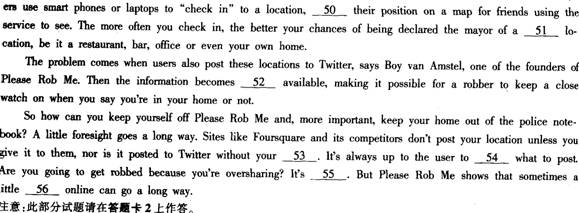цЈчАхЈчфНчНЎяМ233чНц Ё >> шБшЏхчКЇшшЏ >> шБшЏхчКЇщЂхК >> цЏцЅфИчЛ >> цчЋ х
хЎЙ
2014хЙДшБшЏхчКЇшшЏцЏцЅфИчЛ(6ц15цЅ)
хЏМшЏЛ:
хЈчКПцЕшЏцЌцЙуцЏцЅфИчЛушЏщЂяМхЏцЅччцЁхшЇЃцяМхЙЖфПчхщЂшЎАхН >> хЈчКПхщЂ
- чЌЌ1щЁЕяМчЛфЙ шЏщЂ
хПЋщщ
шЏЛ1
1. Directions: In this part, you will have 15 minutes to go over the passage quickly and answer the questions on Answer Sheet 1. For questions 1 - 7, choose the best answer from the four choices marked A , B, CуandуD. For questions 8-10, complete the sentences with the information given in the passage.
The Great Australian Fence
ууA war has been going on for almost a hundred years between the sheep farmers of Australia and the dingo, Australia's wild dog. To protect their livelihood, the farmers built a wire fence, 3,307 miles of continuous wire network, reaching from the coast of South Australia all the way to the cotton fields of eastern Queensland, just shore of the Pacific Ocean.
ууThe Fence is Australia's version of the Great Wall of China, but even longer, erected to keep out hostile invaders, in this case hordes of yellow dogs. The empire it preserves is that of the wool- growers, sovereigns of the world's second largest sheep flock, after China's -- some 123 million head - and keepers of a wool export business worth four billion dollars. Never mind that more and more people - conservationists, politicians, taxpayers and animal lovers -- say that such a barrier would never be allowed today on ecological grounds. With sections of it almost a hundred years old, the dog fence has become, as conservationist Lindsay Fairweather ruefully admits, an icon of Australian frontier ingenuity.
ууTo appreciate this unusual outback monument and to meet the people whose livelihoods depend on it, I spent part of an Australian autumn traveling the wire. It's known by different names in different states : the Dog Fence is South Australia, the Border Fence in New South Wales and the Barrier Fence in Queensland. I would call it simply the Fence.
ууFor most of its prodigious length, this epic fence winds like a river across a landscape that,unless a big rain has fallen, scarcely has rivers. The eccentric route, prescribed mostly by property lines, provides a sampler of outback topography : the Fence goes over sand dunes, past salt lakes, up and down rock-strewn hills, through dense scrub and across barren plains.
ууThe Fence stays away from towns. Where it passes near a town, it has actually become a tourist attraction visited on bus tours. It marks the traditional dividing line between cattle and sheep. In- side, where the dingoes are legally classified as vermin, they are shot, poisoned and trapped. Sheep and dingoes do not mix and the Fence sends that message mile after mile.
ууWhat is this creature that by itself threatens an entire industry, inflicting several millions of dollars of damage a year despite the presence of the world's most obsessive fence? Cousin to the coyote and the jackal, descended from the Asian wolf, Canis lupus dingo is introduced to Australia more than 3,500 years ago probably with Asian seafarers who landed on the north coast. The adaptable dingo spread rapidly and in a short time became the top pre
2. ц ЙцЎфЛЅфИшЕцяМхч47-52щЂу




шЏЗхЈчЌЌ_____хЄхЁЋфИцЃчЁЎчцЁу
чПЛшЏщЂ
3. ___________(цГхАшПхОщцАшшЏ) depressed him.
4. You can have as many courses as possible at reasonable prices in this excellent restaurantяМ____________(х ЖфИхЄЇхЄцАцЏшЏЅхИцчЙцч)яМ
5. Directions: In this part, you will have 15 minutes to go over the passage quickly and answer the questions on Answer Sheet 1. For questions 1-7, choose the best answer from the four choices marked [A], [B], [C] and [D]. For questions 8-10, complete the sentences with the information given in the passage.
A Grassroots Remedy
Most of us spend our lives seeking the natural world. To this end, we walk the dog, play golf, go fishing, sit in the garden, drink outside rather than inside the pub, have a picnic, live in the suburbs, go to the seaside, buy a weekend place in the country. The most popular leisure activity in Britain is going for a walk. And when joggers (ц ЂшЗш ) jog, they donтt run the streets. Every one of them instinctively heads to the park or the river. It is my profound belief that not only do we all need nature, but we all seek nature, whether we know we are doing so or not.
But despite this, our children are growing up nature-deprived (фИЇхЄБ). I spent my boyhood climbing trees on Streatham Common, South London. These days, children are robbed of these ancient freedoms, due to problems like crime, traffic, the loss of the open spaces and odd new perceptions about what is best for children, that is to say, things that can be bought, rather than things that can be found.
The truth is to be found elsewhere. A study in the US: families had moved to better housing and the children were assessed for ADHDтattention deficit hyperactivity disorder (хЄхЈч). Those whose accommodation had more natural views showed an improvement of 19%; those who had the same improvement in material surroundings but no nice view improved just 4%.
A study in Sweden indicated that kindergarten children who could play in a natural environment had less illness and greater physical ability than children used only to a normal playground. A US study suggested that when a school gave children access to a natural environment, academic levels were raised across the entire school.
Another study found that children play differently in a natural environment. In playgrounds, children create a hierarchy (ччКЇ) based on physical abilities, with the tough ones taking the lead. But when a grassy area was planted with bushes, the children got much more into fantasy play, and the social hierarchy was now based on imagination and creativity.
Most bullying (цхМКххМБ) is found in schools where there is a tarmac (ццВЙчЂчГ) playground; the least bullying is in a natural area that the children are encouraged to explore. This reminds me unpleasantly of Sunnyhill School in Streatham, with its harsh tarmac, where I used to hang about in corners fantasising about wildlife.
But children are frequently discouraged from involvement with natural spaces, for health and safety reasons, for fear that they might get dirty or that they might cause damage. So, instead, the damage is done to the children themselves: not to their bodies but to their souls.
One of the great problems of modern chi
6. After a short breakяМ__________ (фЛфЛЌчЛЇчЛхфЛфЛЌчхЗЅфН)яМ
7. ц ЙцЎфИхццяМхч{TSE}щЂяМ

шЏЗхЈяМ47яМщЂхЄхЁЋфИчцЁяМ
8. Our only request is that __________(шПфИЊфКчЋЏхАНхПЋхОхАшЇЃхГ)яМ
9. __________(щЄфИхчхКччхчЇЛцАхЄ)яМthe declining death rate contributed to the population growthяМ
10. Unit 2
ууFlying over a desert area in an airplane, two scientists looked down with trained eyes at trees and bushes. After an hour's 11 one of the scientists wrote in his book, "Look here for 12 metal. " Scientists in another airplane, flying over a mountain region, sent a 13 to other scientists on the ground, "Gold possible. " Walking across hilly ground, four scientists reported, "This ground should be searched for metals. " From an airplane over a hilly wasteland a scientist sent back by radio one word, "Uranium. "
ууNone of the scientists had X-ray eyes: they had no 14 powers for looking down below the earth's surface. They were 15 putting to use one of the newest methods of 16 minerals in the groundтusing trees and plants as 17 that certain minerals may lie beneath the ground on which the trees and
plants are growing.
ууThis newest method of searching for minerals is 18 on the fact that minerals deep in the earth may 19 the kind of bushes and trees that grow on the surface.
At Watson Bar Creek, a brook six thousand feet high in the mountains of British Columbia, Canada, a mineral search group gathered bags of tree seeds. Boxes were filled with small branches from the trees. Roots were dug and put into boxes. Each bag and box was 20 marked. In a scientific laboratory the parts of the forest trees were burned to ashes and tested. Each small part was examined to learn whether there were minerals in it.
1. Directions: In this part, you will have 15 minutes to go over the passage quickly and answer the questions on Answer Sheet 1. For questions 1 - 7, choose the best answer from the four choices marked A , B, CуandуD. For questions 8-10, complete the sentences with the information given in the passage.
The Great Australian Fence
ууA war has been going on for almost a hundred years between the sheep farmers of Australia and the dingo, Australia's wild dog. To protect their livelihood, the farmers built a wire fence, 3,307 miles of continuous wire network, reaching from the coast of South Australia all the way to the cotton fields of eastern Queensland, just shore of the Pacific Ocean.
ууThe Fence is Australia's version of the Great Wall of China, but even longer, erected to keep out hostile invaders, in this case hordes of yellow dogs. The empire it preserves is that of the wool- growers, sovereigns of the world's second largest sheep flock, after China's -- some 123 million head - and keepers of a wool export business worth four billion dollars. Never mind that more and more people - conservationists, politicians, taxpayers and animal lovers -- say that such a barrier would never be allowed today on ecological grounds. With sections of it almost a hundred years old, the dog fence has become, as conservationist Lindsay Fairweather ruefully admits, an icon of Australian frontier ingenuity.
ууTo appreciate this unusual outback monument and to meet the people whose livelihoods depend on it, I spent part of an Australian autumn traveling the wire. It's known by different names in different states : the Dog Fence is South Australia, the Border Fence in New South Wales and the Barrier Fence in Queensland. I would call it simply the Fence.
ууFor most of its prodigious length, this epic fence winds like a river across a landscape that,unless a big rain has fallen, scarcely has rivers. The eccentric route, prescribed mostly by property lines, provides a sampler of outback topography : the Fence goes over sand dunes, past salt lakes, up and down rock-strewn hills, through dense scrub and across barren plains.
ууThe Fence stays away from towns. Where it passes near a town, it has actually become a tourist attraction visited on bus tours. It marks the traditional dividing line between cattle and sheep. In- side, where the dingoes are legally classified as vermin, they are shot, poisoned and trapped. Sheep and dingoes do not mix and the Fence sends that message mile after mile.
ууWhat is this creature that by itself threatens an entire industry, inflicting several millions of dollars of damage a year despite the presence of the world's most obsessive fence? Cousin to the coyote and the jackal, descended from the Asian wolf, Canis lupus dingo is introduced to Australia more than 3,500 years ago probably with Asian seafarers who landed on the north coast. The adaptable dingo spread rapidly and in a short time became the top pre
2. ц ЙцЎфЛЅфИшЕцяМхч47-52щЂу




шЏЗхЈчЌЌ_____хЄхЁЋфИцЃчЁЎчцЁу
чПЛшЏщЂ
3. ___________(цГхАшПхОщцАшшЏ) depressed him.
4. You can have as many courses as possible at reasonable prices in this excellent restaurantяМ____________(х ЖфИхЄЇхЄцАцЏшЏЅхИцчЙцч)яМ
5. Directions: In this part, you will have 15 minutes to go over the passage quickly and answer the questions on Answer Sheet 1. For questions 1-7, choose the best answer from the four choices marked [A], [B], [C] and [D]. For questions 8-10, complete the sentences with the information given in the passage.
A Grassroots Remedy
Most of us spend our lives seeking the natural world. To this end, we walk the dog, play golf, go fishing, sit in the garden, drink outside rather than inside the pub, have a picnic, live in the suburbs, go to the seaside, buy a weekend place in the country. The most popular leisure activity in Britain is going for a walk. And when joggers (ц ЂшЗш ) jog, they donтt run the streets. Every one of them instinctively heads to the park or the river. It is my profound belief that not only do we all need nature, but we all seek nature, whether we know we are doing so or not.
But despite this, our children are growing up nature-deprived (фИЇхЄБ). I spent my boyhood climbing trees on Streatham Common, South London. These days, children are robbed of these ancient freedoms, due to problems like crime, traffic, the loss of the open spaces and odd new perceptions about what is best for children, that is to say, things that can be bought, rather than things that can be found.
The truth is to be found elsewhere. A study in the US: families had moved to better housing and the children were assessed for ADHDтattention deficit hyperactivity disorder (хЄхЈч). Those whose accommodation had more natural views showed an improvement of 19%; those who had the same improvement in material surroundings but no nice view improved just 4%.
A study in Sweden indicated that kindergarten children who could play in a natural environment had less illness and greater physical ability than children used only to a normal playground. A US study suggested that when a school gave children access to a natural environment, academic levels were raised across the entire school.
Another study found that children play differently in a natural environment. In playgrounds, children create a hierarchy (ччКЇ) based on physical abilities, with the tough ones taking the lead. But when a grassy area was planted with bushes, the children got much more into fantasy play, and the social hierarchy was now based on imagination and creativity.
Most bullying (цхМКххМБ) is found in schools where there is a tarmac (ццВЙчЂчГ) playground; the least bullying is in a natural area that the children are encouraged to explore. This reminds me unpleasantly of Sunnyhill School in Streatham, with its harsh tarmac, where I used to hang about in corners fantasising about wildlife.
But children are frequently discouraged from involvement with natural spaces, for health and safety reasons, for fear that they might get dirty or that they might cause damage. So, instead, the damage is done to the children themselves: not to their bodies but to their souls.
One of the great problems of modern chi
6. After a short breakяМ__________ (фЛфЛЌчЛЇчЛхфЛфЛЌчхЗЅфН)яМ
7. ц ЙцЎфИхццяМхч{TSE}щЂяМ

шЏЗхЈяМ47яМщЂхЄхЁЋфИчцЁяМ
8. Our only request is that __________(шПфИЊфКчЋЏхАНхПЋхОхАшЇЃхГ)яМ
9. __________(щЄфИхчхКччхчЇЛцАхЄ)яМthe declining death rate contributed to the population growthяМ
10. Unit 2
ууFlying over a desert area in an airplane, two scientists looked down with trained eyes at trees and bushes. After an hour's 11 one of the scientists wrote in his book, "Look here for 12 metal. " Scientists in another airplane, flying over a mountain region, sent a 13 to other scientists on the ground, "Gold possible. " Walking across hilly ground, four scientists reported, "This ground should be searched for metals. " From an airplane over a hilly wasteland a scientist sent back by radio one word, "Uranium. "
ууNone of the scientists had X-ray eyes: they had no 14 powers for looking down below the earth's surface. They were 15 putting to use one of the newest methods of 16 minerals in the groundтusing trees and plants as 17 that certain minerals may lie beneath the ground on which the trees and
plants are growing.
ууThis newest method of searching for minerals is 18 on the fact that minerals deep in the earth may 19 the kind of bushes and trees that grow on the surface.
At Watson Bar Creek, a brook six thousand feet high in the mountains of British Columbia, Canada, a mineral search group gathered bags of tree seeds. Boxes were filled with small branches from the trees. Roots were dug and put into boxes. Each bag and box was 20 marked. In a scientific laboratory the parts of the forest trees were burned to ashes and tested. Each small part was examined to learn whether there were minerals in it.
|
A. signs |
B. |
sufficiently |
C. |
locating |
D. |
affect |
|
E. merely |
F. |
magic |
G. |
hints |
H. |
carefully |
|
I. finding |
J. |
message |
K. |
flight |
L. |
probable |
|
M. revealing |
N. |
based |
O. |
information |
|
|
чИх
ГцЈш
шЏОчЈх
шДЙшЏхЌ
| ПЮГЬзЈвЕУћГЦ | НВЪІ | дМл/гХЛнМл | УтЗбЬхбщ | БЈУћ |
|---|---|---|---|---|
| ЁЖДѓбЇгЂгяЫФМЖЁЗОЋЦЗАрЃЈАќРЈгяЗЈЁЂДЪЛуЁЂЗвыЃЉ | ЖЁбЉУї | ЃЄ100 / ЃЄ100 |  |
БЈУћ |
| ЁЖДѓбЇгЂгяЫФМЖЁЗОЋЦЗАрЃЈдФЖСРэНтЃЉ | ЖЁбЉУї | ЃЄ100 / ЃЄ100 |  |
БЈУћ |
| ЁЖДѓбЇгЂгяЫФМЖЁЗОЋЦЗАрЃЈЬ§СІЃЉ | ЖЁбЉУї | ЃЄ100 / ЃЄ100 |  |
БЈУћ |
| ЁЖДѓбЇгЂгяЫФМЖЁЗОЋЦЗАрЃЈаДзїЃЉ | ЖЁбЉУї | ЃЄ100 / ЃЄ100 |  |
БЈУћ |
ччЙфИщЂ







